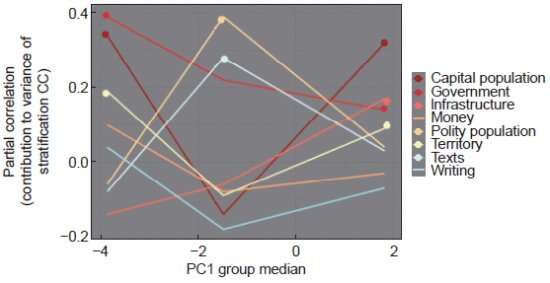Information processing tied to emergence of hierarchy in human societies

Using case studies and ethnographic examples, anthropologists have for some time proposed that the emergence of hierarchical structures in human societies was in part a product of attempting to overcome cognitive limits in the number of people any one person can deal with simultaneously without hitting information processing challenges. The building of a vast new dataset that goes beyond these case studies and attempts to track variables describing all societies throughout human history and pre-history is now allowing social theories to be tested on a much larger number of examples.
A paper describing the use of this dataset to test the ideas of a seminal figure in the anthropology of the emergence of social complexity, Gregory Johnson, appeared in the Journal of Social Computing on February 10.
In the last few decades, anthropologists, archeologists and historians have begun to explore the relationship between demography, information processing and the organizational structures of societies. One influential researcher over the past quarter century in particular, Gregory Johnson, an archeologist specializing in the development of complex societies in the Near East, proposed that a principle of cost-benefit optimization could explain why so many small-scale social structures had taken on similar forms.
At the core of this explanation was the concept that there is a cognitive limit on the number of active interactions any one person can have with others—in other words, one person can only deal with so many other people at one time before getting confused. Social psychologists studying group dynamics have found that for groups assigned any arbitrary task, five people is consistently reported by participants to be about the right number.
Beyond this number, individual interactions among members are hard to maintain and so the groups must either re-organize or split up (fission). With respect to social structures, such re-organization or fissioning must occur in order to keep the total number of information channels connecting individuals within such cognitive limits and to avoid communications stress (also referred to as "scalar stress").
Johnson's consideration of case studies from the Near East and beyond echoed the findings of social psychologists and suggested that a threshold exists at group sizes of about six or so people where the re-organization first occurs. This re-organization takes the form of some type of hierarchical organization in order to overcome the scalar stress on group performance in decision-making as it increases in size.
At the same time, there might be spatial or technological techniques that could work to mitigate the cognitive challenge. For example, infrastructural developments such as roads, postal systems, or couriers could increase communication efficiency and thereby reduce scalar stress. Likewise, technical improvements in data processing such as development of writing and accounting systems could offset losses in communications efficiency.
However, Johnson's work and those of other archeologists and anthropologists exploring the relationship between society's scale, information-processing capabilities and hierarchical structures were all drawn from a few handfuls of ethnographic examples, with a limited set of population data and their corresponding types of organizational forms.
But in 2011, a worldwide group of scholars established the Seshat databank project, which has systematically collected data using some 1,500 variables to describe societies throughout history and pre-history, from villages to empires, and how they change over time at 100-year intervals.
"I wanted to see if we could test Johnson's propositions about hierarchy emergence and information processing on this much larger dataset," said Laura Ellyson, the author of the paper and an archeologist at Washington State University, "and see which kinds of developments had the greatest impact on hierarchy development for small-, medium-, and large-scale societies."
By applying multiple-linear regression analysis to this much larger Seshet dataset, she found that Johnson's proposal—that the development of hierarchy is influenced by variables such as population and territory size—did hold, at least for small-scale societies. But Prof. Ellyson found that such hierarchy emergence is also influenced by how developed a society's governing system is such as the presence of civic buildings, courts, professional or paid officials and soldiers.
For medium-scale societies, some of Johnson's ideas are also supported as hierarchical development in these groups is reliant upon their population size and their developments of written texts.
But for large-scale societies, rather than overall population size, the data suggest that it is the sizes of their capital populations and their overall territory that have the greatest influence on hierarchical developments, along with further developments of their governments and infrastructure.
Prof. Ellyson now wants to test Johnson's ideas about the fissioning and even collapse of societies and how this relates to information processing. Johnson had explored these questions using reported numbers of decision-making units within each level of a hierarchy and the overall population, as well as using data concerning the frequency of disputes within a society.
The Seshet databank does not yet include this level of detail in terms of number of officials at each hierarchical level or a proxy measure for disputes such as court cases or warfare data. However, the project does have plans for coding these types of variables in the future.
More information: Laura J. Ellyson, Applying Gregory Johnson's Concepts of Scalar Stress to Scale and Information Thresholds in Holocene Social Evolution, Journal of Social Computing (2022). DOI: 10.23919/JSC.2021.0017
Provided by Tsinghua University




















